Soil and Landscape Animations
A series of animations are provided to show processes relevant to soil and landscapes with a particular focus on agricultural systems and landscapes. The 'back' button can be used to navigate back to this page.
| Carbon cycle animation Carbon is essential to life on earth, with every living organism needing carbon to sustain life whether for physical structure, or as an energy source, or both. This animation shows the carbon cycle from an agricultural prospective. | 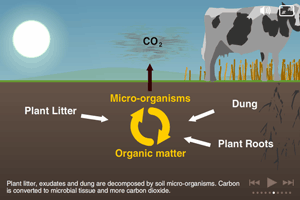 A scene from an animation explaining the soil carbon cycle |
| Nitrogen cycle animation Approximately 78 % of the earth's atmosphere is nitrogen, however, atmospheric nitrogen is unavailable for biological use. Atmospheric nitrogen must undergo an important process called fixation to make it available for plants to use. The animation shows the nitrogen cycle from an agricultural prospective. |  A scene from an animation showing the nitrogen cycle |
| Crop Growth In The High Rainfall Zone The High Rainfall Zone animation is an easy to understand visual representations of crop development, wheat growth stages and the influence of climate and cultivar on grain yield. | 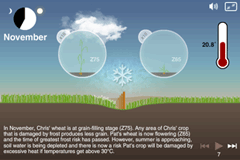 Screen grab taken from the high rainfall zone animation |
| Diagrammatic representations of Terrace development The animation shows how 'terraces' are created by stream activity over hundreds of thousands of years. The animation provides a simplified illustration of how terraces have developed in the river valleys of the Maffra region and explains differences in soil types between them. | 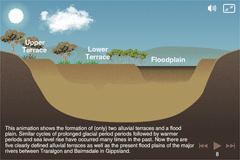 A diagrammatic representations of Terrace development |
| Soil phosphorus cycle in a grazing system Phosphorus is essential to grow crops and pastures, and productive agriculture depends on it. Phosphorus is often added to the soil through fertiliser and other organic inputs, and living organisms within the soil are responsible for transforming P into forms that are available to plants. The following animation provides a simple illustration of the cycle of P in soil in a grazing system. | 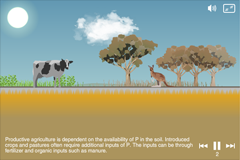 A diagrammatic representations of soil phosphorus cycle in a grazing system |
| Soil phosphorus in the agricultural landscape The distribution of P over a farm landscape is often uneven, with inputs from animals and fertilisers greater in some areas, and losses from erosion and runoff greater in other areas. Phosphorus is often moved around the landscape by harvesting pasture or crop from one area, and feeding to livestock in another. The management of P inputs and the movement of P around the farm landscape will benefit the land manager financially, and also decrease the likelihood of P losses into waterways. The following animation provides a simple illustration of the cycle of P in soil in an agricultural landscape. | 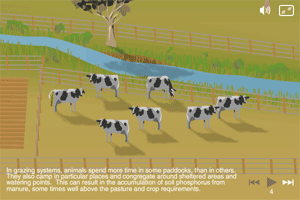 A diagrammatic representations of soil phosphorus in the agricultural landscape |
| Dispersion process animation This animation demonstrates the difference between exchangeable cations on clay dispersion of two dry aggregates of a sodic soil dispersing when hydrated. It is possible to interact with the dry aggregates of sodic soil in the dispersion animation. | 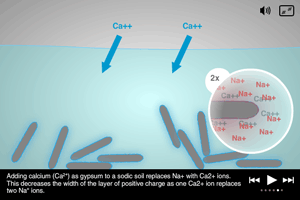 A scene from an animation that explains the process of soil dispersion |
| Acidification animation The acidification of agricultural soils is a common problem in some areas. This animation provides a simple illustration of the complex process of soil acidification in an agricultural context. The following animation provides a simple illustration of the formation of acid sulfate soils and how they may be exposed to oxygen through various means of soil disturbance. | 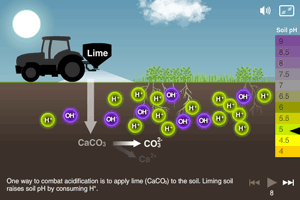 A scene from the soil acidification process animation |
| Coastal Acid Sulfate Soil animation Coastal acid sulfate soils occur naturally in some landscapes and if left undisturbed, can be harmless. If they are disturbed, i.e. water drains from the soil and air enters, they can react with oxygen and produce sulfuric acid. The following animation provides a simple illustration of how acid sulfate soils may be exposed to oxygen through various means of soil disturbance. | A scene from an animation that shows causes of coastal acid sulfate soil |
| Sub surface drip irrigation animation Subsurface drip irrigation (SDI) systems involve the placement of permanent drip tapes below the ground surface to supply water directly to the crop root zone. The animation shows a SDI system from a dairy agricultural prospective. This animation shows how a surface drip irrigation system works. | An animation showing how a subsurface drip irrigation system works |


